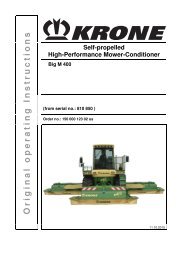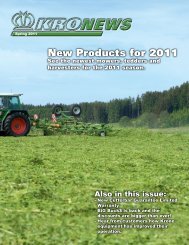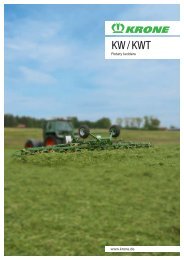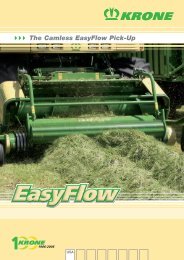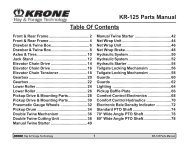The BiG Pack Road Show - Krone North America
The BiG Pack Road Show - Krone North America
The BiG Pack Road Show - Krone North America
You also want an ePaper? Increase the reach of your titles
YUMPU automatically turns print PDFs into web optimized ePapers that Google loves.
<strong>The</strong> Future of theDairy Market By: Blake FullerSome of you are probablywondering which way the dairy pricesare going to go in the next couplemonths. Are they going to go up?Are they going to go down? Well,as a Territory Product Manager for<strong>Krone</strong> <strong>North</strong> <strong>America</strong>, I have talkedto a lot of people and done a lot ofresearch to answer this question foryou. I found a lot of good informationin an article written by RobertCropp of the University of Wisconsin-Madison with reference to the outlookof the dairy market. I want to thankhim for writing this article.According to the ChicagoMercantile Exchange’s website, ClassIII milk was at $16.34 per hundredweighton September 14th, 2010.October 2010 milk is up to $16.58 perhundredweight, but after December2010, the futures market drops backoff into the $14’s.In August, we saw an increasein milk production from a year ago.Statistics show that this increase is approximately3%, the largest increasethis year. <strong>The</strong> reason for this increaseis attributed to higher milk productionper cow and an increase in thenation’s cow herd. <strong>The</strong> cow herd inthe U.S. has increased close to 65,000head since last December.Milk prices continue to improveover a year ago. July Class IIIprice was $13.74, $3.77 higher thanthe $9.97 a year ago. August ClassIII milk was above $15.10 comparedto $11.20 a year ago. Cheese priceshave strengthened and the dry wheyprice has stayed steady in the $.40 perpound range. Cheddar barrels were at$1.56 per pound or higher during themonth of August, improving from anaverage of $1.36 per pound in June.Total cheese production was 5.2%higher and second quarter cheeseexports are up 87% from a year ago.CME butter prices are at levelsnot seen since June of 2004. <strong>The</strong>reis a strong demand for cream for icecream and other class II products.June butter production was 5.6%lower than a year ago and June 30thbutter stocks were 24.7% lower than ayear ago. Butterfat exports have beenstrong with second quarter exportsup 218% from a year ago. <strong>The</strong>re is aconcern that these prices may dampenretail sales. December cash-settledbutter futures are settling at $1.77 perpound.Nonfat dry milk powderexports were 76% above a year agofor the second quarter, but worldprices have softened and exports maybe slowing. Western nonfat dry milkprices were $1.30 per pound at theend of June. <strong>The</strong>y are now in the$1.15 range. June 30th nonfat drymilk stocks were 13.2% lower than ayear ago but building with stocks 18%higher than May.<strong>The</strong> question we all want answeredis will milk prices continue tostrengthen throughout the rest of theyear? <strong>The</strong> following factors point tofurther increases in milk prices withClass III futures reaching the high$15’s: lower than normal milk compositionreducing the yield of manufacturedproducts per 100 pounds ofmilk; the normal seasonal decline inmilk production; more hot and humidweather that depressed milk per cow;the opening of schools which increasesfluid (beverage) milk sales andcheese sales; the completion of the10th round of CWT removing morethan 34,000 cows; and anticipateddairy exports continuing above levelsa year ago.Crucial to higher milk prices isthe level of total milk production. <strong>The</strong>level of milk production will continueto depend upon whether thenation’s cow herd continues to buildas well as how much milk each cow isproducing. Prior to the 10th round ofCWT, cow slaughter was running belowa year ago. July 1st cattle inventoryshowed dairy replacements 3%higher than a year ago averaging 44.5per 100 milk cows compared to 42.9a year ago. <strong>The</strong>re is the potentialthat milk production could continueto run close to 2% higher than a yearago. This will challenge much highermilk prices unless domestic demandand exports improve more than nowexpected. Fluid milk sales as wellas <strong>America</strong>n cheese sales have beenrunning a little below a year ago, butsales of other cheeses have been muchimproved over last year.<strong>The</strong> continuation of higherdairy exports will be important inmaintaining and further strengtheningmilk prices for the remainder of theyear. I foresee Chinese milk importsto continue to increase due to high demand.This could help the domesticdairy market. <strong>The</strong>re have also beentalks of the U.S. government gettinginvolved to try and stabilize the dairymarket. <strong>The</strong> increase in the price ofcotton will take many acres out of hayproduction. With the decrease in hayacres and the increase in dairy prices,this should bode well for hay growers.Class III futures are settling above$15.00 through December, but backinto the $14’s at the start of 2011.<strong>The</strong>re is still a good possibility thatprices could do better than this.10 - KroNews










